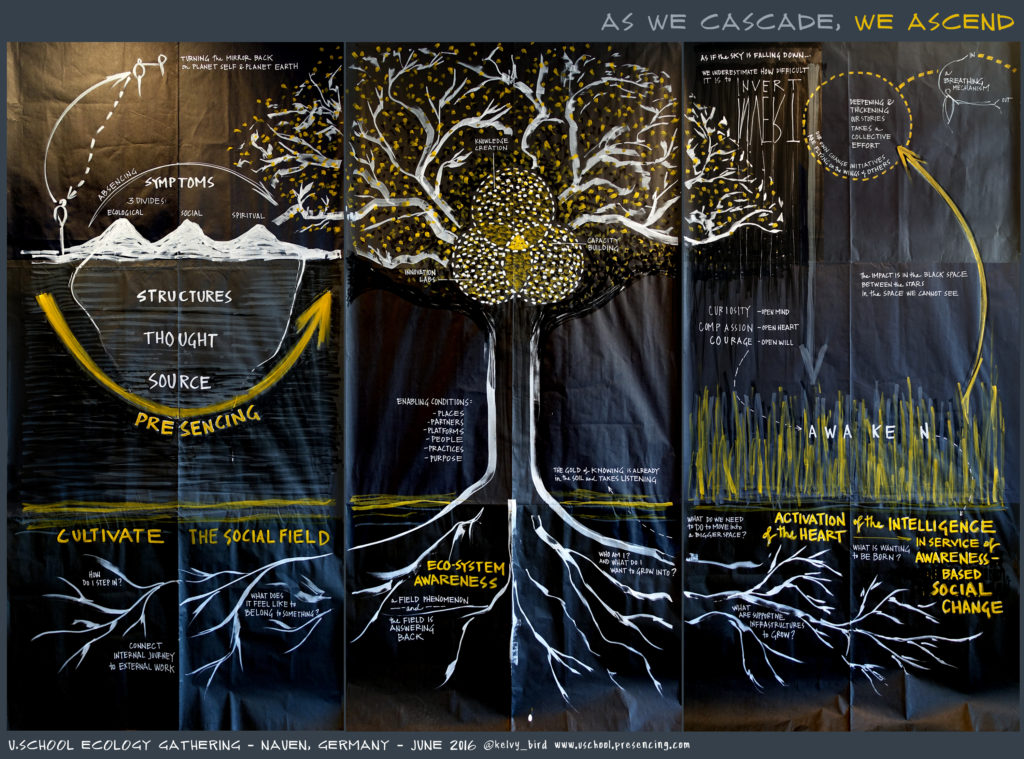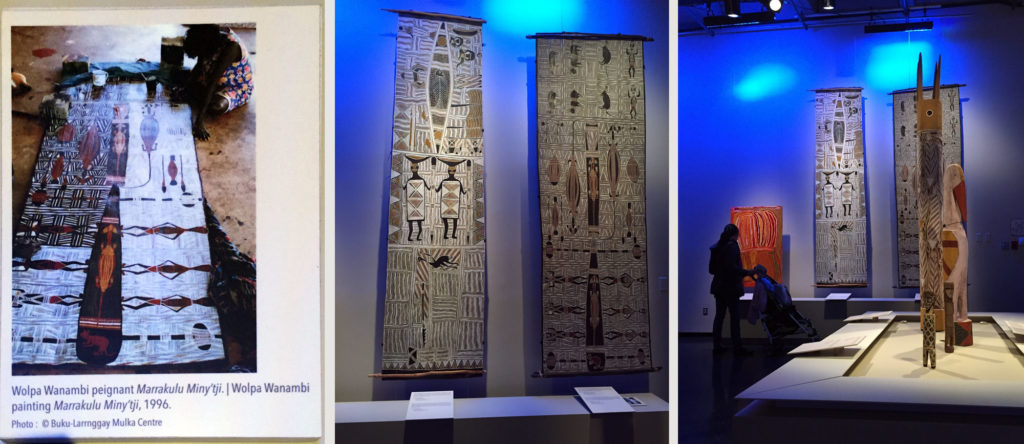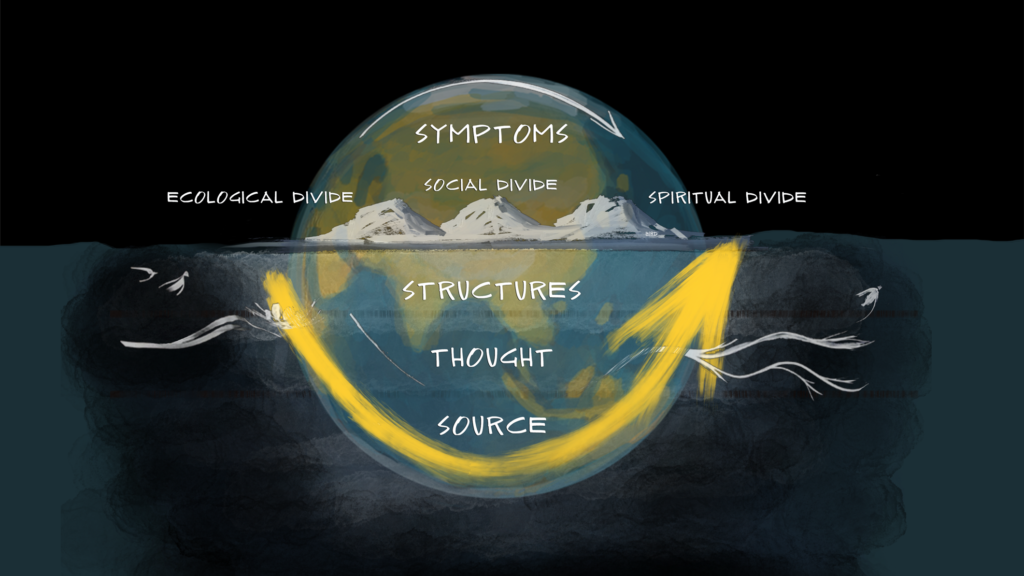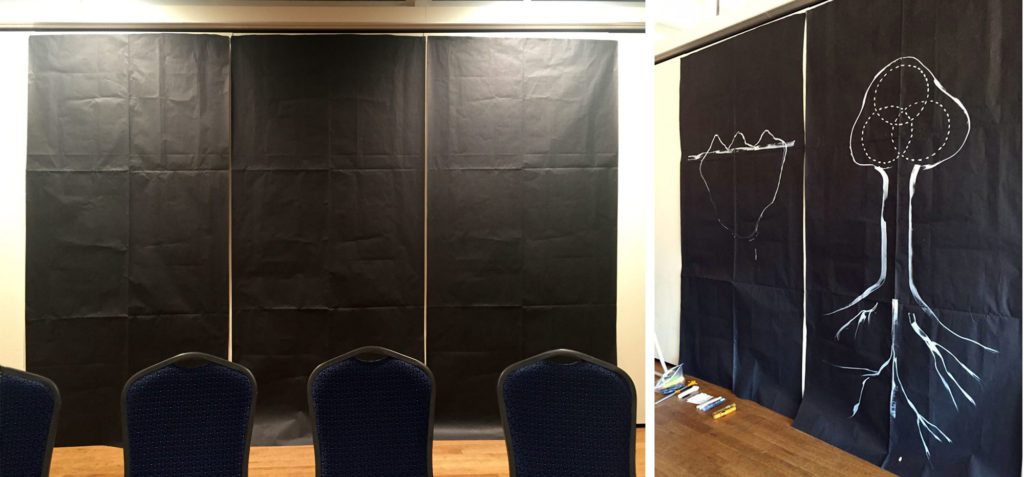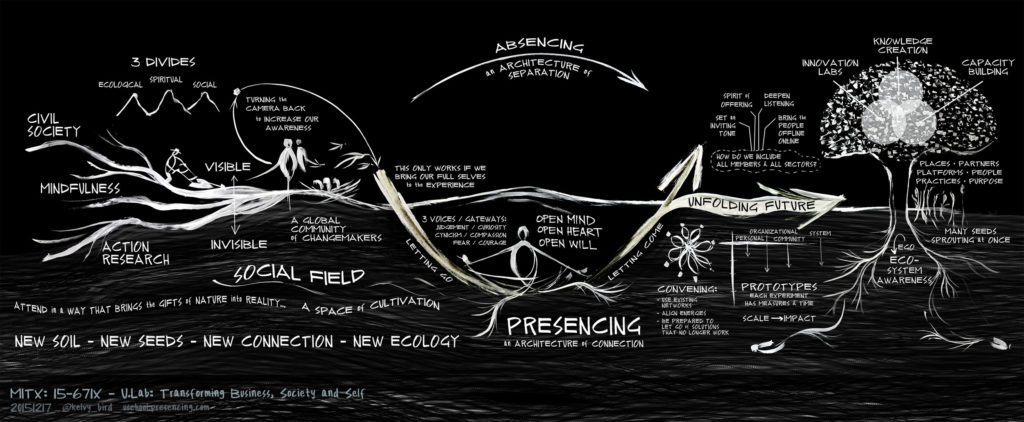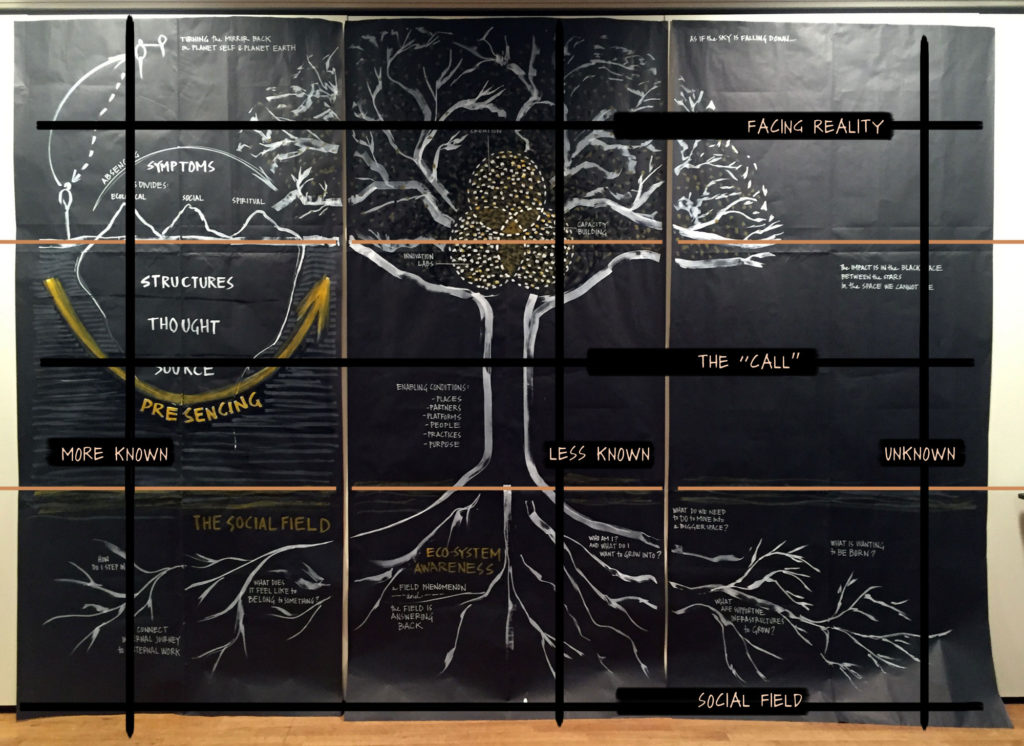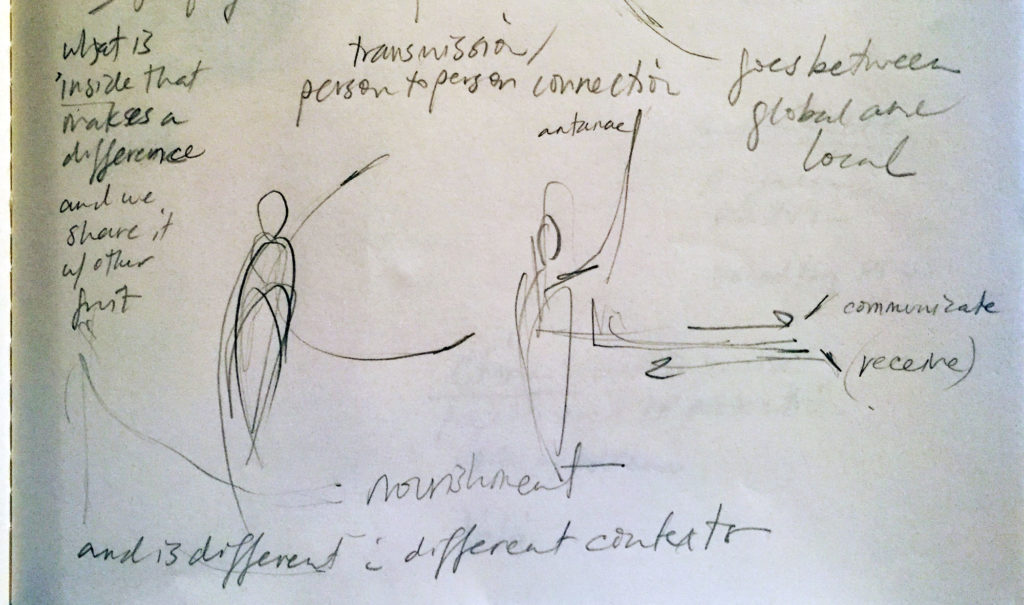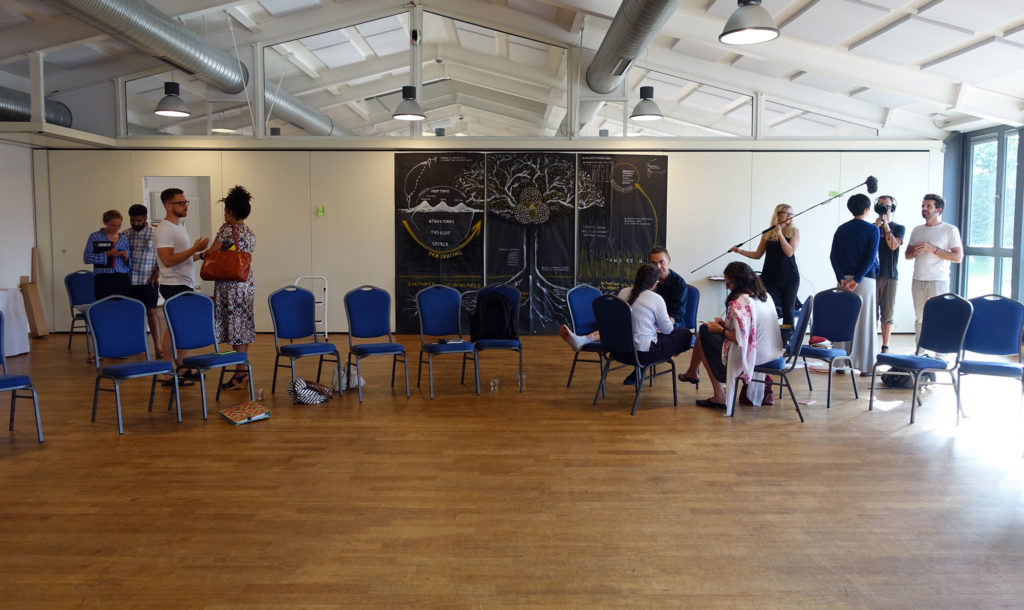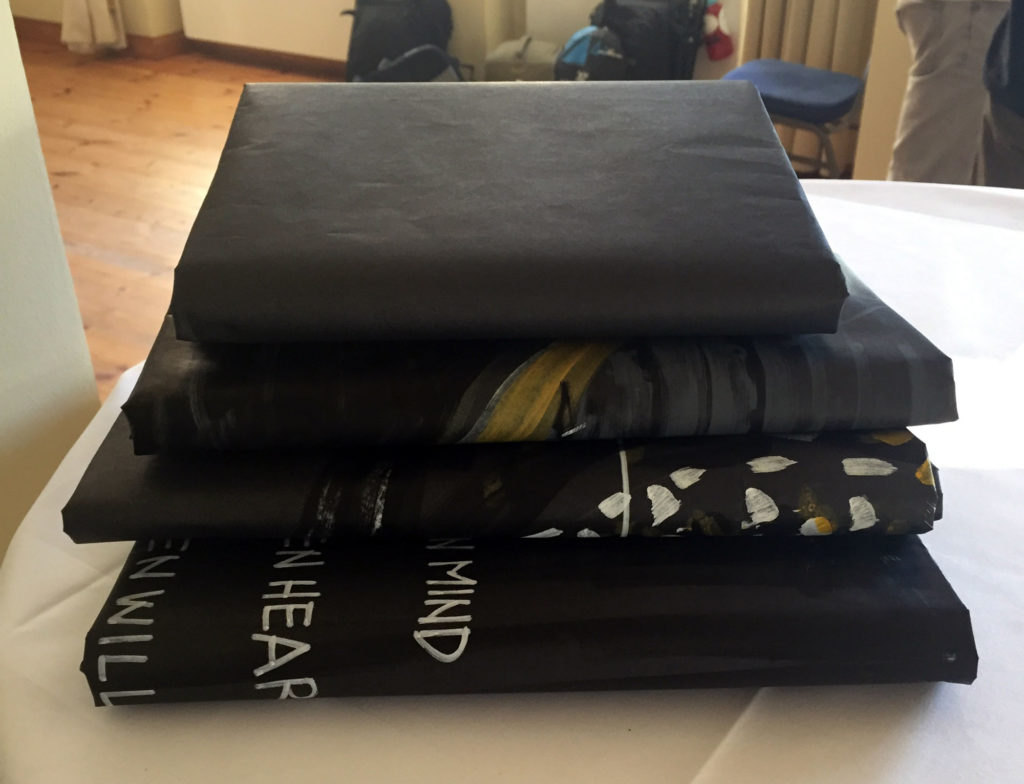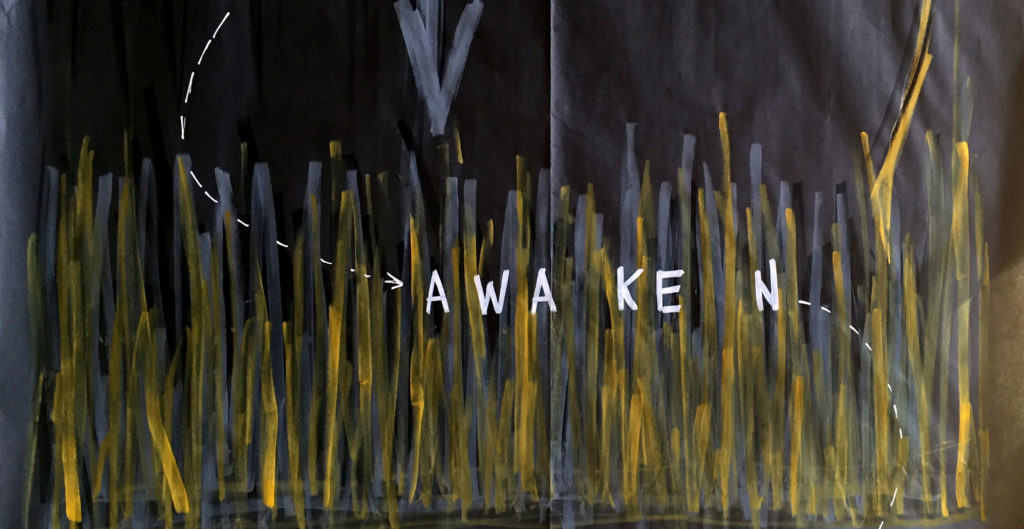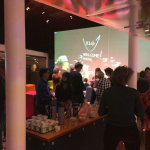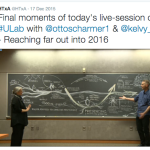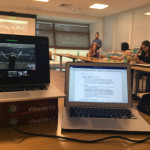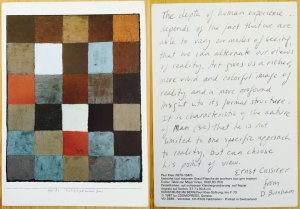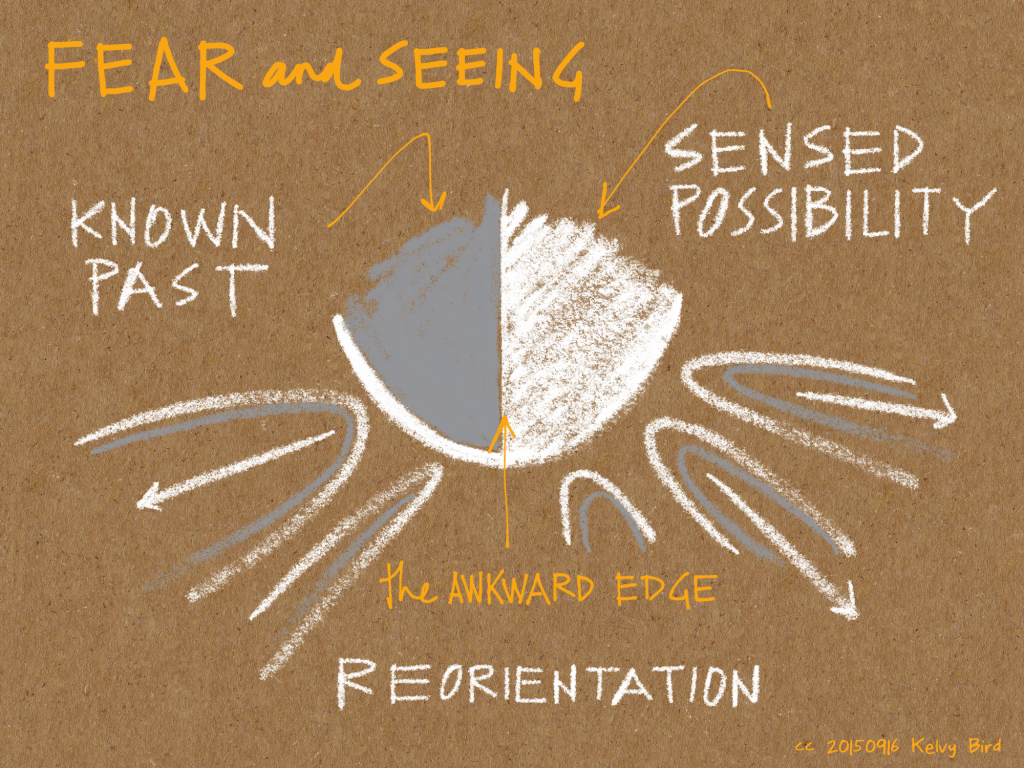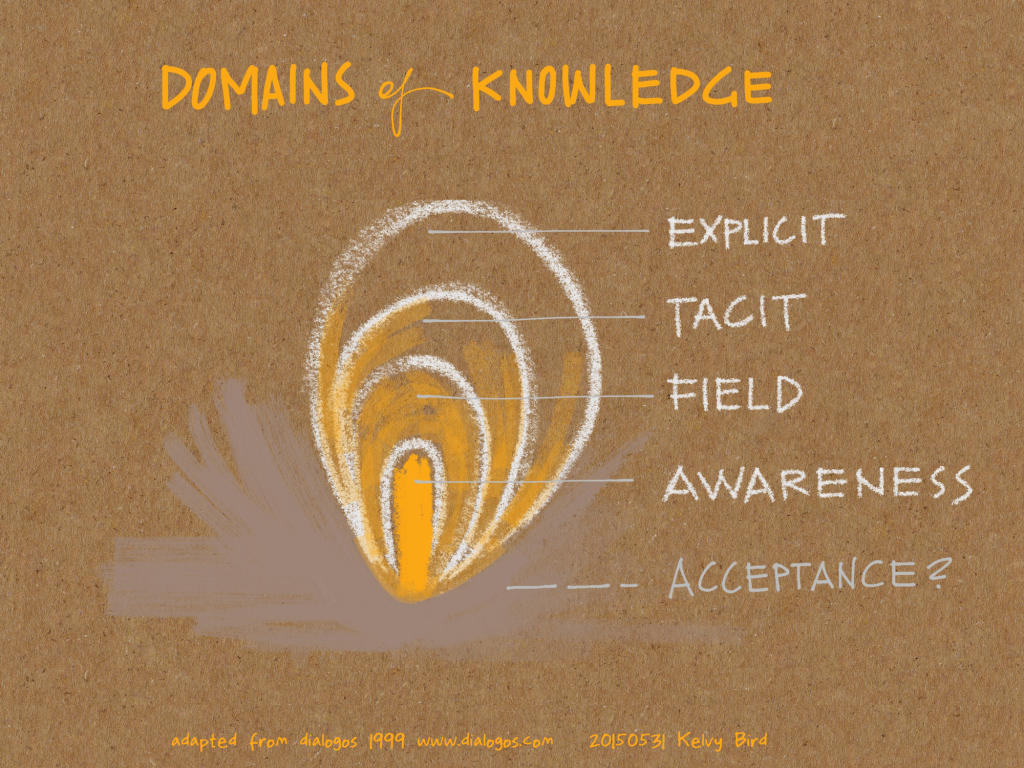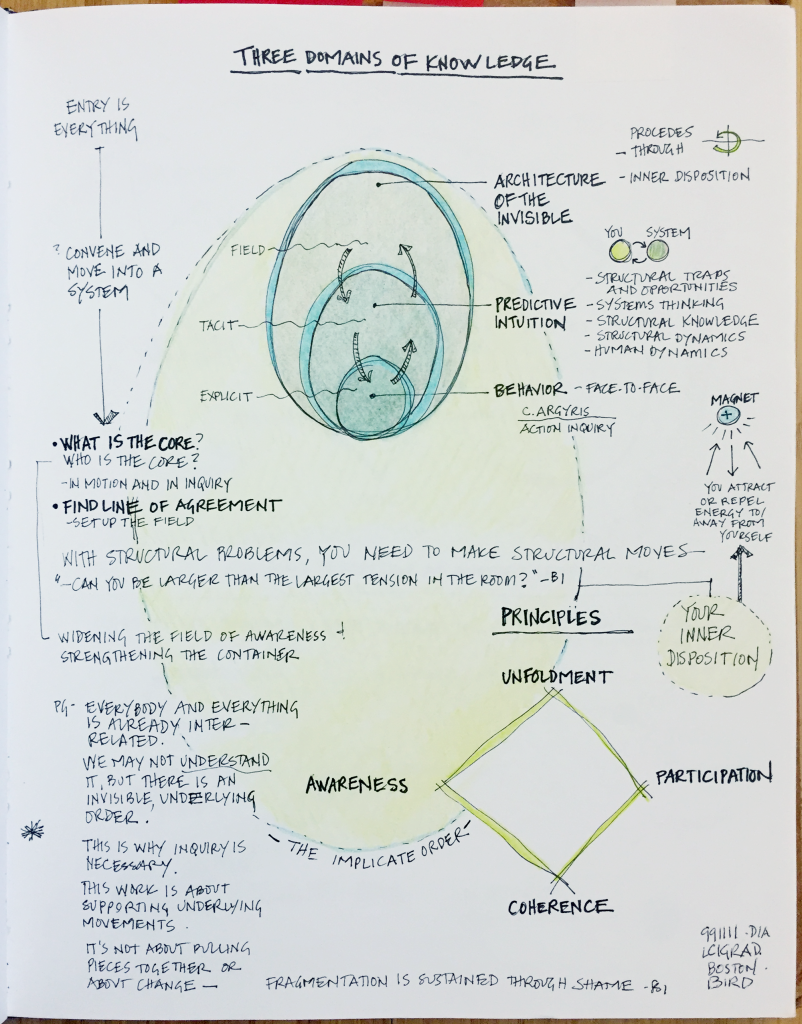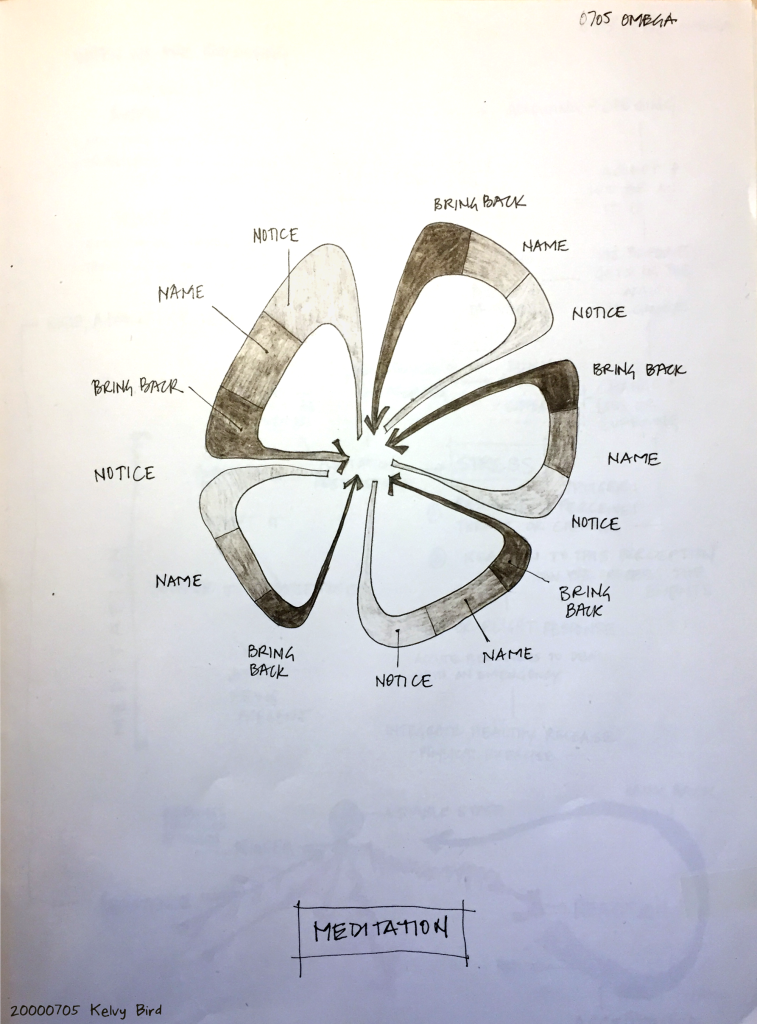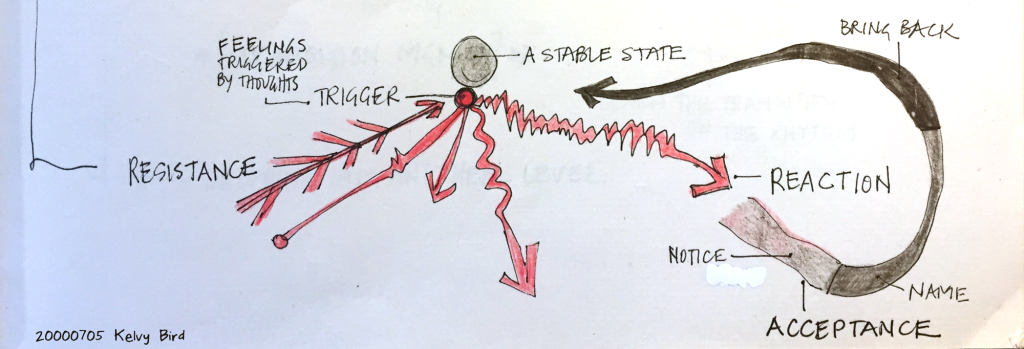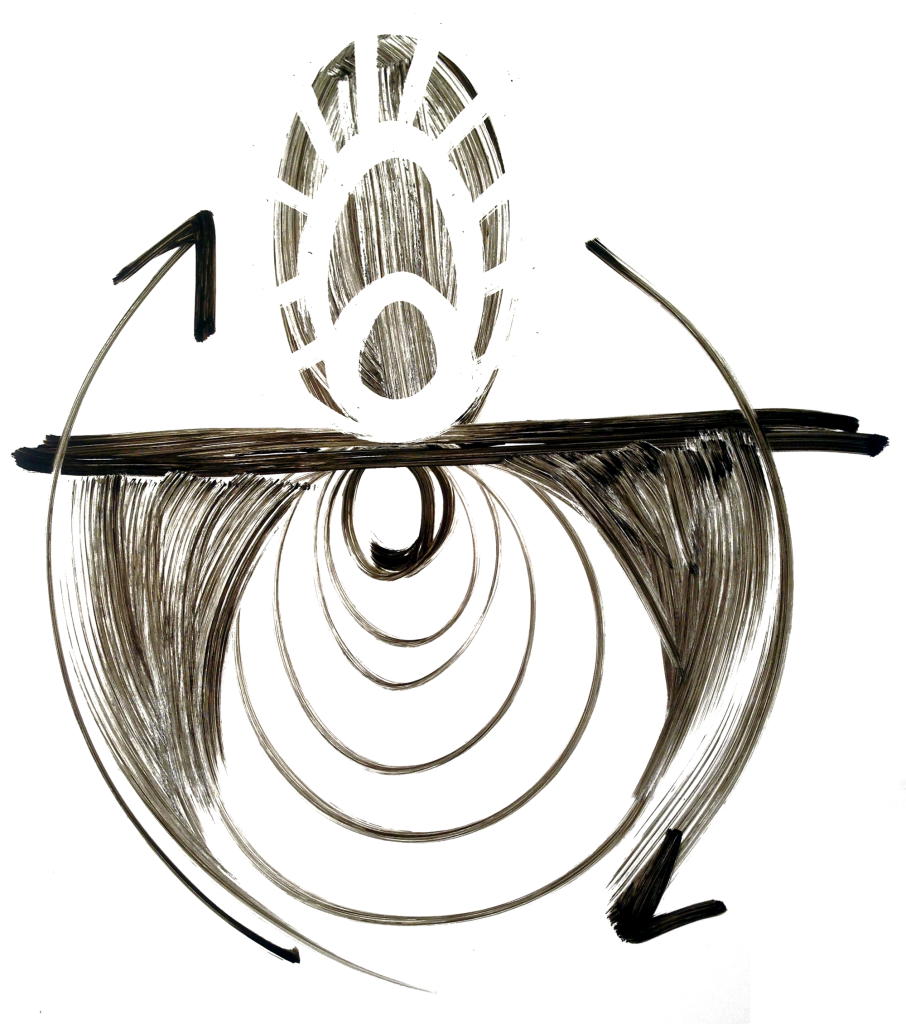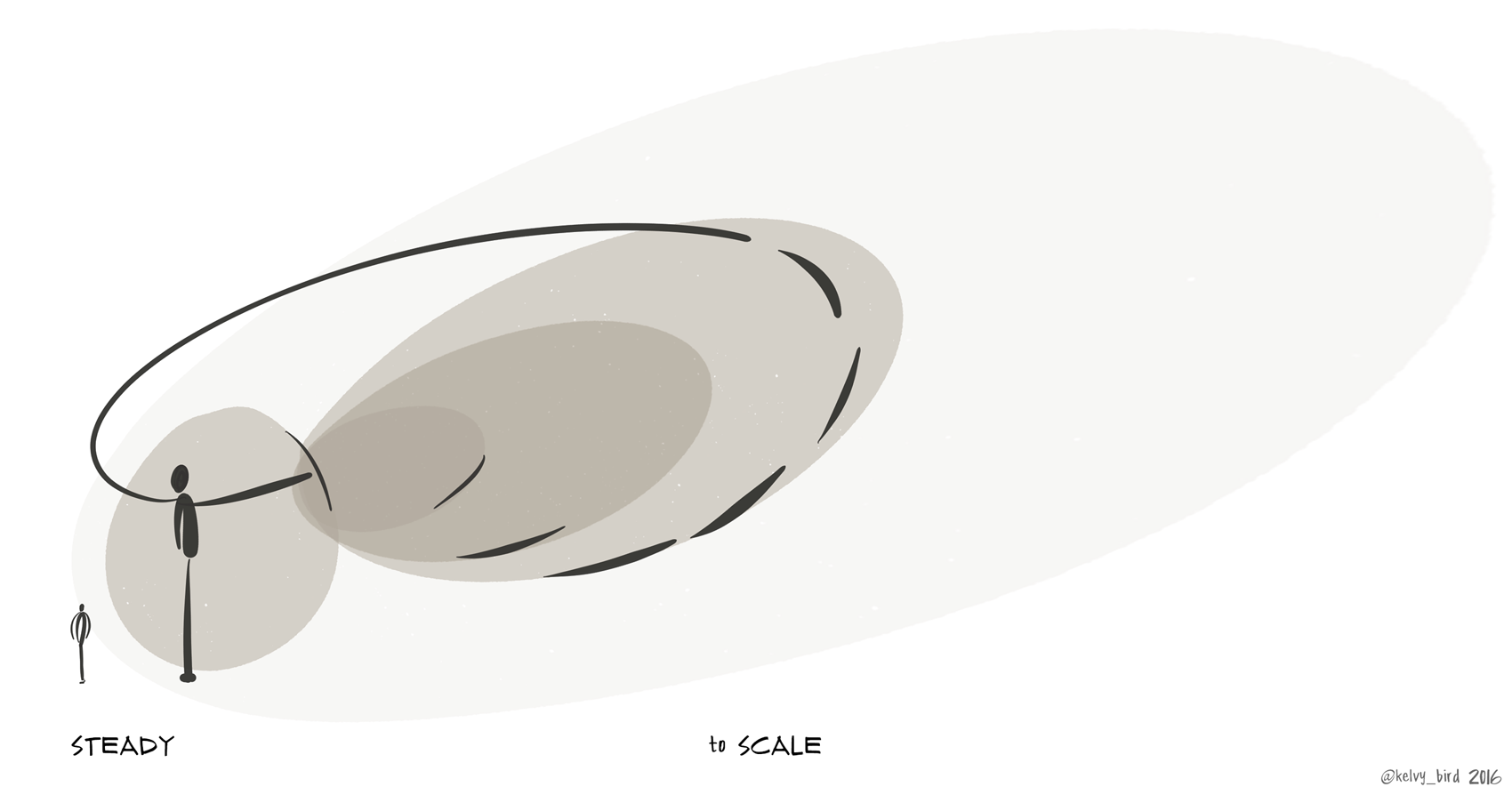
Artists reflect their times through lenses that influence insight and action, in themselves and in others. In the face of truly great art, we find our spirits lifted, our views challenged, and sometimes our very foundation of understanding tectonically shifted. Art moves us, and our species evolves with this kind of internal stirring.
As visual practitioners, as artists, we aim with care and responsibility to reach people, to expand the boundaries of the assumed known. Any reach requires steadiness, and to ensure a stable core, we rely on support for our essential, creative selves.
Take the example of an apple tree: Weak branches yield little fruit. The stronger the trunk, the stronger the branch. The stronger the roots, the stronger the trunk. The richer the soil, the more nourishment for the roots and the fruit. And so on.
Scribing with an eye towards the orchard and the village beyond – with an intent to facilitate systems-level seeing – I experience a direct correlation between the steadiness of one’s being and the range of insight that visuals can summon.
This works in a reciprocal way, where we are both held in by others to experience integrity and wholeness, and because of this, we generate visuals as a holding device for learning within systems.
This kind of support is what I’ll refer to as “containers”, which we can consciously form by considering how we hold ourselves, how we help others energetically through the use of images, and also how we let ourselves be held.
More attention, stronger tree, healthier orchard. Less attention, the field goes fallow.
To inhabit this kind of reciprocal zone of tending / flourishing / nourishing, I’ll map out my thinking in three main parts:
- An explanation of containers,
- Thoughts on quality of presence and inner cultivation
- Two specific examples of practice where container intentionality directly influenced a scale of reach for the drawings and the content they carried.
Containers
As my grandmother was aging, at a point when she could really only go outside with a walker and physical assistance, I recall visits where we would lunch at a local NYC diner. She would ask me things about my life, about school, about my friends, about my studies, and she would marvel at the complexity of the world in which I lived. (This was 1984, so we can only imagine what she would say about our world today!)
What I recall most poignantly is the way she would pay attention, seeming to hang on every word, and the way she made me feel safe, and loved, loved no matter what I would say, no matter what I had to share. I never felt judged. No matter what she thought about the details of my escapades, she would listen closely, look me in the eye, and continue to pursue an understanding of my life.
She provided a container, a space where I could see myself more clearly and grow as direct result of how she was holding me.
When my grandmother, somewhat hard of hearing and surely with many of her own personal concerns, was completely able to show up for me, I was completely able to show up for her. I could be more vulnerable, because I felt safe. She brought out the purest part of me by how gracefully she held me in her own heart.
Drawing with Container Awareness
There exist depths, or phases, to containers that directly correlate with attention.
By listening with the following levels in mind, we can participate in a shift of awareness and possibility. Otto Scharmer[i] has described “Four Levels of Listening” that I apply here to the visual practice of scribing.
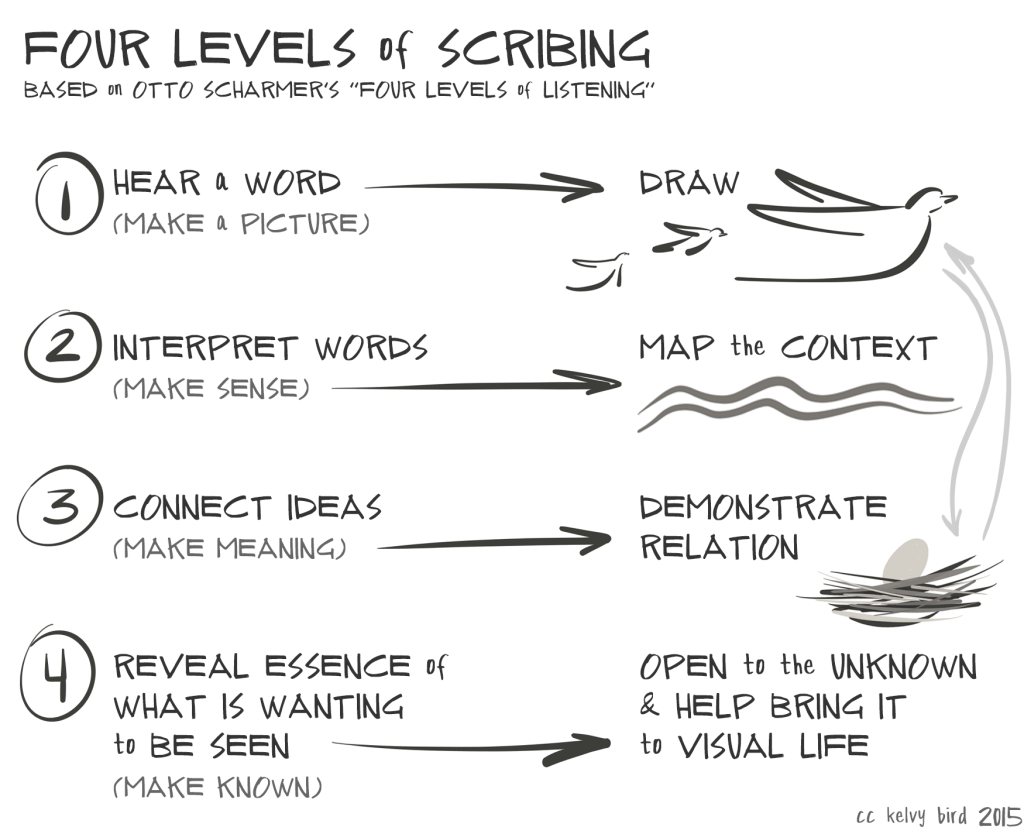
At Level One, quoting Otto, we “Download and listen to reconfirm what we already know. What we see is limited to our own projections, reflecting the past.”
In scribing, we draw what we hear, and it’s literal. Someone says “bird” and we draw a bird. I also refer to this as “object-oriented” scribing, where a focus on individual, named parts is the primary approach.
Level Two represents “Factual Listening. We notice difference, and we notice disconfirming data.”
We see what is being spoken from a broader vantage point, and still draw what we hear, but our lens expands to make sense of what is being spoken within a context, which we can map. “The bird is flying, then it reaches the coast and joins a flock,” and we enter the domain of storytelling.
Level Three shifts to “Empathic Listening, seeing the situation through the eyes of another, leading to emotional connection. Listening begins to happen from the Field, or from the other person with whom you are connecting.”
This is where containers start to really activate, where our own heart comes online as we step into the shoes of another–like my grandmother opened space to witness and feel out my shoes. We start to care, genuinely care, and we shift. What comes through us shifts. Our drawing shifts. (How can it not?!)
We realize the story in the room is coming from a cultural frame of reference beyond the room; the facts coming out have causal underpinning. No bird, no story, exists as an island. Something came before the lone bird flying, and something will come after. To get at the structural dynamic, we must activate our attunement to the negative space, what is going on between the notes or objects, the subtler envelope within which the parts form a whole. We shift from noticing moments in time to sensing movements over time. As we inquire, we start to inhabit the story and make sense of it with the company.
And Level Four, Generative Listening, “requires us to connect with a capacity to let go and let come, to connect with an emerging future possibility that helps us to connect more fully with who we are and who we want to be.”
This can be said also for Level Four scribing; we sense into and help surface the highest potentiality for the systems we serve. To do this requires a sensitivity with the energy of what is wanting to come through, an energy or vibe that has started to become tangible in Level Three. What is drawn is secondary to meeting the tone accurately and crafting gestures that evoke essential meaning.
I find here that time slows, the air quiets, and a kind of creative rupture takes place in the midst of sublime stillness, where something very fine and as-yet-unnamable is coming alive, and we, as scribes, witness it; in a way we are midwives facilitating, through our being and our hands, an emergence of some communal shift and knowing.
This could be described as Flow, or the Zone, and is rare. It takes a well-tended container–at tiers of the self, room and system–to reach this place, whether it be between two people or 70,000, in a window of an hour or decade. Numbers don’t even really matter.
What does matter is the qualitative listening behind the act of drawing, the listening that comes online by orienting within the context of a social body, with a core intent to join an invisible place and make manifest that which wants to be seen and witnessed.
Waking to Container Relativity
Our range of attention is ours to define, and the relative properties of containers give us choice: stay within the accepted known or expand to meet a not-yet-named-reality.
An old Hindu parable, first heard in a year-long program called Leadership for Collective Intelligence[ii] and paraphrased here, further explains the value of perspective in regards to holding capacity:
An aging master grew tired of his apprentice complaining, and so, one morning, sent him for some salt.
When the apprentice returned, the master instructed the young man to put a handful of salt in a glass of water and drink it. “How does it taste?” the master asked. “Bitter!” spit the apprentice. The master chuckled.
The two walked in silence to a nearby lake, where the master again asked the young man to put a handful of salt in the water.
“Now drink from the lake. How does it taste?” “Fresh!” remarked the apprentice. “Do you taste the salt?” asked the master. “No,” said the young man.
At this, the master sat beside the young man and offered:
“The pain of life is pure salt; no more, no less. The amount of pain in life remains the same, exactly the same. But the amount of bitterness we taste depends on the container into which we put the pain.
So when you are in pain, the only thing you can do is to enlarge your sense of things… Stop being a glass. Become a lake.”
We are both lake-makers and salt, depending on the context. At times, we are held in by a person or group, and that enables us to show up more securely. At other times, we expand to help a group in need meet their challenge. It works both ways. And we expand or contract depending on the need of the moment.
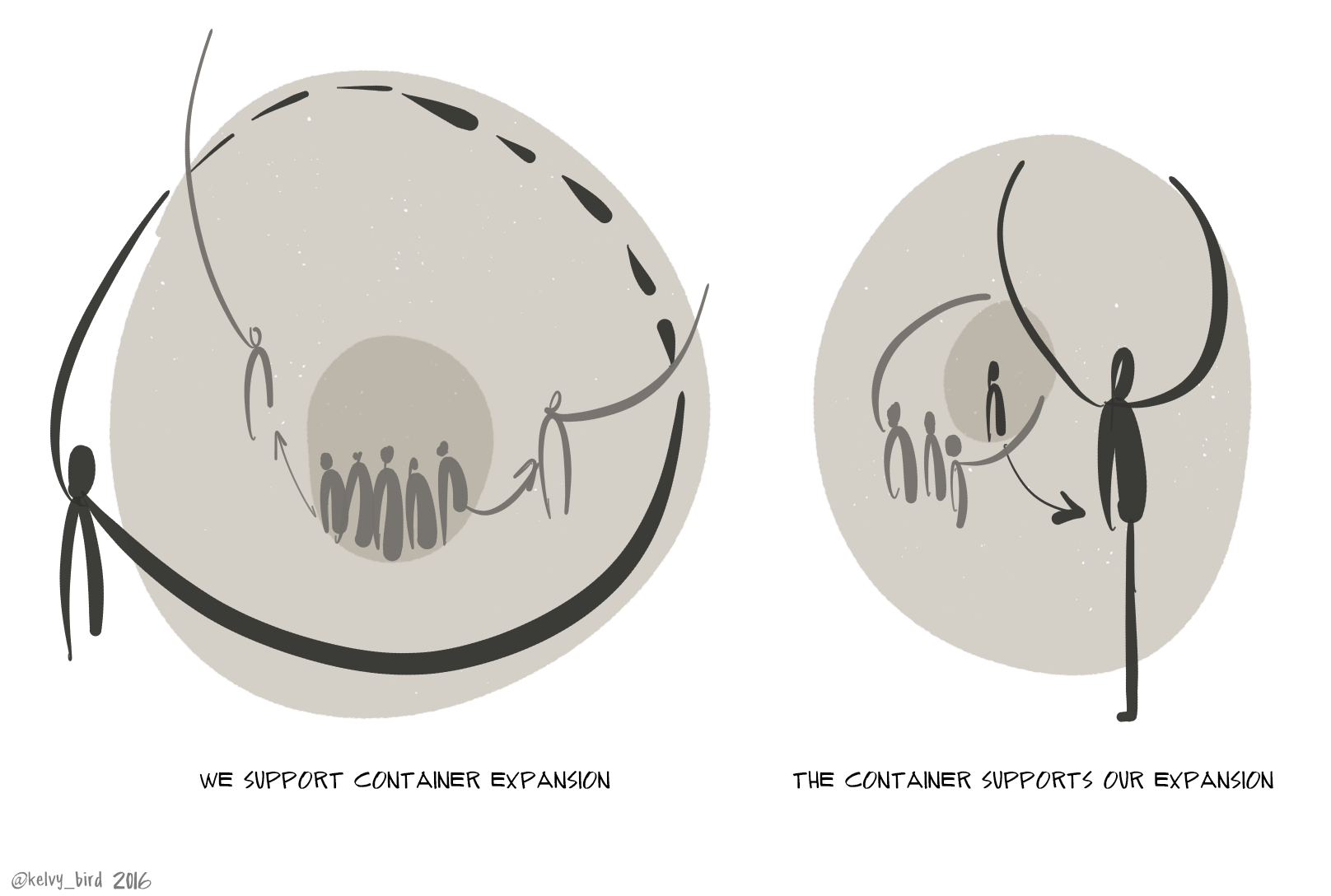
Inner Cultivation
Towards forming these types of enlarging holding spaces for others, and before even making a mark on any wall, we must first learn to cultivate a container for ourselves, opening our stance, to stay clear for what wants to ‘move through.’
We start by locating our best self – the self that accepts, that chooses possibility over fear – the self that welcomes the new, and actually carves a path for it. In orienting with this self, we serve as a microcosm of reorientation for every part of a system that our drawings might touch.
This can be a conscious, enlightened, spiritual choice. It’s also simply a matter of relaxing into the fact that–through every gesture, every word, every silence even–we exist in a cascading ripple of touch. Our presence allows us to show up for others, joining individuals and groups precisely where they are in their process, poised in a receptive and steadying way.
A rigid stance blocks, separates, reinforces a dualistic mentality: you|them; you|content; imagined you|true you – the “you” with the most to actually offer any given situation. As we steel up we stand guarded, sectioned off. As we soften, we are inevitably moved. Moved, additional senses come online. Attunement amplifies. Range increases. Listening cascades down those Four Levels.
In this place we meet a “knowing” beyond literal understanding of words, concepts, and impressions. An intuitive muscle comes online, and it’s an absorbent place, where – because of our open stance – we can facilitate a group from monologic to dialogic interaction.
The range of our attention relates to that which is taken in, received, and then that which is turned outward, revealed, through the hand. It’s a mutual relation; the more open the scribe, the more received. The more received, the more revealed.
We are reflective aids and, as such, our attention to personal containers helps stabilize that of the room and systems we address. If the room feels rattled and we collapse into that, we echo rattledness. Yet if we are able to stabilize internally, we’re more likely to reveal cohesion.
Draw with crystal clear intention. To make a mark before a mark wants to be made risks destabilizing the container through misrepresentation or by being out-of-sync with the true tone of the room.
Scribing is a participatory art. There are consequences to over-stacking, to overdrawing – that the image indulges the artist’s needs to express and shifts away from the marks actually called for by the container.
Examples of Practice
To land these concepts in very real application, I can speak to two engagements that each fully tested the limits of my practice. The data might sound extreme; I include it as an objective reference point in regards to the tides of container-building and scale. The stories evolved between 2013-2015 and continue as this book goes to print (NOTE: see end of post for information on an upcoming Visual Anthology).
u.lab
One example is of a Massive Open Online Course (MOOC) called “u.lab: Transforming Business, Society, and Self” offered jointly through Edx and the Presencing Institute. The gist of u.lab is that, after seven years of ramp up with experiments in online broadcasts and community-building, our team live-streamed eight times in 2015, reaching 70,000 registered participants from 185 countries, a social body made of individuals, small teams, and over 500 self-organized hubs alike.
I am such a shy person, and the notion of thousands of people watching my back made me want to crawl in a hole until the next ice age was over. To prepare, I wore soothing blackboard-matching grey, extracted chalk ink from pens to paint large-arching arrows, imagined myself one trunk in the orchard, tuned into the notion of water – extending the lake metaphor – and drew. My approach over the year, across dozens of images generated live and staged across multiple web platforms, shifted from a logical representation of frameworks to a heated extraction of some intuited field essence, which seemed most appropriate to the container that had matured globally over time.
It would have been easy to consider the u.lab “we” as a body of “users” rather than as an alive eco-system, since my voice-to-voice or email communication had only been with ~.003% of the participants, and it was hard to tune into the reality of those I might never know. But without attentional inclusion, I would reinforce the very pattern of societal disconnect we were seeking to address and dissolve. The stance I chose to occupy, then, was one of unbounded connection, where rather than an “out there” viewership, I was surrounded by a sea of individuals helping to hold me to the wall. I was contained by the very eco-system for which I drew.
Left: u.lab Netherlands Hub during live session. Photo by Maurice van Rooijen, TheoryUlab.nl.
Middle: A screenshot posted in Twitter, taken by a participant during the live broadcast.
Right: Sao Paulo Hub during the same live session. Photo by Adam Yukelson.
Executive Education
The other practical example of container application is of a custom leadership program offered through MIT’s Executive Education (of the Sloan School of Management) that offered an experiment in endurance and sense-making over long blocks of time and numerous sessions.
A highly skilled MIT team, working closely with top-level executives, customized a transformational program for senior managers from a global organization with 23,000 employees.
There have been five cohorts to date – I worked with the last three – each going through a 9-month program that included an 8-day section of intensive classes, followed by a few months of applied project work, concluding with another 8-day section.
Most of the 8-day sections involved 4-6 hours of faculty presentation per day, with each section leading to ~45 total hours of scribing onto ~100+ linear feet of dry-erase walls and sometimes extra boards. This yielded 118 unique images over the 3 full cycles, including topics on: Systems Thinking, Leadership and Organizational Change, Strategy, Finance and Macro-Economics, and Operations–most of which I did not initially know well or at all.
What was unique here was not the volume of time or images, but was the necessary weaving of content over the educational arc. One approach could have been “one topic, one picture”. The more expansive value, though, was in the wrapping of heavily-related drawings around the group, stitched nest-like, providing a solid visual container for extended cultural learning.


Two classrooms at MIT, where drawings offered visual and content containment through Executive Education customized programs
As initially indicated, the extension of new experience directly relates to the depth and steadiness of the soil in which it grows.
Visual practice, as a key “seeing” and anchoring device within the containers we support, serves a foundational role in our understanding of, and the evolution of, social fields. Thus, a visual practitioner’s grasp of the correlation – between our role as scribes and the fields in which we draw – cannot be underrated; as artists participating in societal transformation, we are implicate[iii] in both making apparent, and the expansion of, discovery.
Our times are riddled with disconnects, ideological entrenchment, crisis, fear. It is a time then, with open eyes,[iv] to see. It is a time to expand, to scale, to facilitate societal sight. All inner preparation – and all holding spaces we reinforce – enable the very act of making that meets this call.
Each crooked nook, fault line, gorgeous arc, blotch of color, textured application in our drawing can offer some structural integrity and some sense.
As artists, as visual practitioners of any kind, it is up to us to stretch “larger than the largest disturbance in the room.”[v]
Increasing our ability to embrace current discomfort, and simultaneously represent the possible, we participate in the engagement and ushering in of tentative, emergent, realities.
[i] Otto Scharmer, Levels of Listening, as found in Theory U: Leading from the Future as it Emerges, first edition, Society for Organizational Learning, 2007 and a video clip from u.lab here: https://www.youtube.com/watch?v=eLfXpRkVZaI
[ii] The Hindu Story and much of my understanding of containers comes from working with Dialogos (www.dialogos.com) and the Circle of Seven (www.ashlandinstitute.org)
[iii] Here lies a subtle reference, honoring physicist David Bohm’s theory of the “Implicate Order” and undivided wholeness. Any interested reader can start to lean more via: http://www.david-bohm.net
[iv] Months after the official Bauhaus closing, Josef Albers was invited to teach at the newly-formed Black Mountain College in Asheville, North Carolina. Despite knowing little English, he knew enough words to convey his purpose for teaching: “To open eyes.” Leap Before You Look: Black Mountain College, 1933–1957, Exhibit at the Institute of Contemporary Art, Boston MA, Oct 2015 – Jan 2016.
[v] William Isaacs
This text represents Draft v6, for the anthology Drawn Together through Visual Practice. In writing this piece, I received an enormous amount of guidance from Brandy Agerbeck, Sam Bradd, and Jennifer Shepherd – and thank each of them with deep gratitude for their patience and steadiness in helping to hold my container intact!

